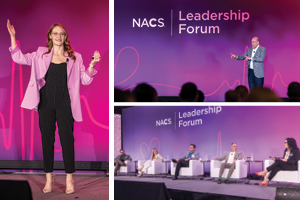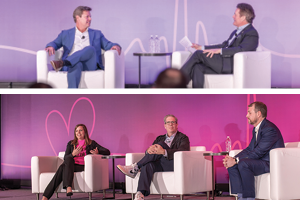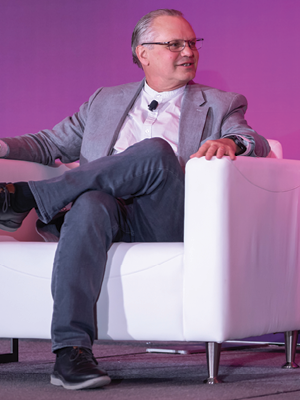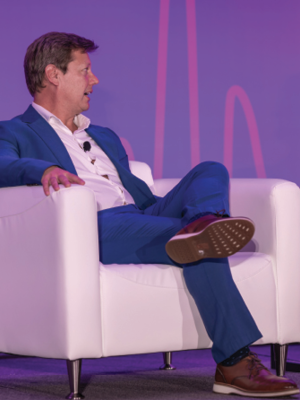At NACS, we are serious about our culture. In July 2005, Henry Armour became president and CEO—the third leader of NACS since its founding on August 14, 1961—and brought forth a clear vision for the organization’s culture.
“We focus on developing a culture of constructive behaviors,” Armour said in a Convenience Matters podcast in 2022. “We relish different perspectives and debate. We want different points of view because that allows us to make better decisions.”
“An intentional culture doesn’t just happen, you have to work at it,” he added.
Leaders make great decisions, but Armour doesn’t believe decision-making is at the core of leadership. “It’s creating an environment in which talented people can achieve far more together than they can individually,” he said, adding that, in convenience, this is where store managers can excel.
“A great store manager creates that environment. It’s role modeling, it’s listening, it’s being responsive, it’s making hard decisions” and it’s being honest, Armour said.
Leaders also have to communicate effectively, especially with their teams.
“There’s downward communication and what I call upward listening because employees want to be heard,” Armour said, adding that they also want to know what’s going on. “They want to know what the new initiatives are, and they especially want to know the why.”
The Vision Begins at the Top
Culture can be a nebulous topic. There is no accepted common definition for culture. It’s invisible yet touches and influences everything, according to Mark Miller, co-founder of Lead Every Day. A good, pragmatic definition of culture, he said, is that it’s the cumulative effect of what people see, hear, experience and believe. Whether intentional or unintentional, all organizations have a culture.
Miller’s team surveyed more than 6,000 global leaders from 10 countries. It found that most leaders in the U.S. admit culture is the most powerful tool at their disposal to drive performance, but it does not rank high on their list of priorities. More like No. 12.
“Your culture is either by design or default, and the ones that are by default are not healthy,” Miller said at this year’s NACS Leadership Forum.

The 72% of leaders who acknowledge culture is important, yet struggle to work on it, are what Miller calls “stuck in quicksand.”
“Quicksand is anything that is impeding your leadership effectiveness,” Miller said. “It’s a toxic mix. It includes things like business complexity, distractions, fear, fatigue and even a little success,” he said.
A leader trying to move through quicksand will have difficulty pulling others out. By extension, the teams surrounding the leader are also stuck, Miller said, adding that this is the No. 1 reason why leaders today are not working on culture.
“Leaders in quicksand are not working on culture—they’re working on survival,” he said.
Your culture is either by design or default, and the ones that are by default are not healthy.”
Miller’s book “Smart Leadership: Four Simple Choices to Scale Your Impact” details how leaders can get out of quicksand (this is a CliffsNotes synopsis):
- Confront reality to stay grounded in the truth and lead from a position of strength.
- Grow capacity to meet the demands of the moment and the challenges of the future.
- Fuel curiosity to maintain relevance and vitality in a changing world.
- Create change today to ensure a better tomorrow.
Next on the journey is getting to a place where culture can flourish. Miller shared several guidelines for building a high-performance culture:
Aspire. “You have to be able to share your hopes and dreams for your culture. … We met far too many leaders around the world who did not have clarity of what they were trying to say. ... To inculcate it and sustain it, people have to know what you’re trying to create.”
Amplify. “Always look for ways to reinforce the aspiration”—role modeling, for example, because people always watch the leader. “If you have a clear aspiration and you amplify it well, you will see movement. You will see behavior change.”
Adapt. Constantly work on enhancing your culture by:
- Jumping on critical gaps immediately.
- Attacking the toxins, or patterns of unhealthy and unproductive behavior.
- Doubling down on strengths. “Culture is the most powerful tool at your disposal.”
- Introducing capabilities. “You can introduce new things to your culture to make it stronger.”
“You may have a new capability that could position you for the future and strengthen your culture simultaneously,” Miller said.
Put Your People First
Good pay and benefits are important, but culture makes the difference.
A 2021 study found that toxic culture was the best predictor of attrition during the first six months of the Great Resignation—it was 10 times more powerful than how employees viewed their compensation in predicting employee turnover, according to MIT Sloan Management Review.
“The way people think about how work fits into their lives is drastically shifting and changing,” said Hannah Ubl, co-founder of Good Company Consulting, at the NACS Leadership Forum.
Remember the golden rule? Treat others the way you want to be treated. Today, there’s the platinum rule: Treat others the way they want to be treated.
“Think about it as feedback, as recognition. … Communicate with others the way they want to be communicated with. If you’re thinking about how to create a people-first culture, it’s constantly making sure that you’re operating by the platinum rule,” she said.
Leaders of a people-first culture are those who:
- Lead with compassion: Meet people where they are and extend grace to others and yourself.
- Treat people as humans, not robots: Prioritize psychological safety—create an environment where ideas are encouraged without the fear of backlash or judgment.
- Lead like a coach: Inspire action, listen more than talk and maximize potential over productivity.
By some accounts, we’ve moved from the Great Resignation to the Great Reassessment, where people are looking for purpose both at home and at work.
“When you think about culture, every single person impacts it,” Ubl said, noting that communication can be the difference between stress and ease. “If we just fixed communication, everything would feel a lot easier.”

A Culture of Belonging
According to McKinsey’s 2021 “Great Attrition” survey, the top three reasons employees quit their jobs were that they didn’t feel valued by their organizations (54%) or their managers (52%) or because they didn’t feel a sense of belonging at work (51%).
“Employees want stronger relationships, a sense of connection and to be seen,” the survey noted.
People want to belong. So much so that conversations about diversity, equity and inclusion have evolved to also focus on belonging, said Katie Mooney, managing director of Seramount. More companies are recognizing that belonging “can inspire productivity and engagement within a culture,” she added.
Ankeny, Iowa-based Casey’s has a team member commitment-based culture that creates engagement and belonging among its 45,000 team members in 17 states. The company’s values statement is on the Casey’s website:
The way people think about how work fits into their lives is drastically shifting and changing.”
“At Casey’s, we believe great companies keep engaged team members by having a strong culture that is founded upon clear values. Our Casey’s CARES culture is built around Commitment, Authenticity, Respect, Evolving and Service.”
According to Nan Thomae, vice president of HR field operations at Casey’s, “We take our values seriously—so seriously that they’re a part of the performance review for all team members, because it takes everyone to create a culture.”
Casey’s conducts engagement surveys of all 45,000 team members, which has an 80% completion rate. The results show how elements of CARES are evolving the team member experience. “Year over year, we’ve seen continued progress in our engagement survey results,” Thomae said.
Colette Matthews, global vice president of customer experience and inclusion executive sponsor at Alimentation Couche-Tard, shared how the global company is creating engagement and belonging through its Women’s Council, which supports underrepresented team members.
“We set an ambition for women in 2018 when we kicked off the Women’s Council, and that was that 30% of women, directors and up, would be represented—and we’ve stayed true to that. Every functional team is tracking that and [is] held accountable,” Matthews said.
She added that every year Couche-Tard’s Women’s Council “celebrates or has two town halls; one is around International Women’s Day, which is a huge initiative for us at Circle K, and the other is around equity.”
Private Label Perspectives
Kwik Trip has seen success with its private label program. Zietlow shared a few considerations for retailers as they launch or expand their own private label assortment.
• Have very strong working relationships with your suppliers.
• Work closely with any relevant regulatory agencies. “Sometimes people view those as adversarial. We choose to work hand-in-hand with them,” Zietlow said.
• If you’re going to produce the products yourself, “It has to be a long game. You’ll have large expenses early on.”
• As a program develops, consider attaching a brand to it and promoting that brand instead of winning on price point alone.
—Ben Nussbaum
People Need To Belong
In 1943, American psychologist Abraham Maslow published “A Theory of Human Motivation,” which described a hierarchy of needs for human survival and fulfillment: physiological, safety/security, belongingness and love, esteem and self-actualization.
Basic needs, such as oxygen, food and water, are at the bottom of the hierarchy, or the base of the pyramid. Safety includes things such as health, financial stability and feeling free from harm. The third need encompasses what this article has been discussing: belonging, where a person focuses on the need for a community and for love.
The Harvard Business Review article “What Does It Take to Build a Culture of Belonging?” noted that because the need to belong is universal and fundamental, “focusing on it has the power to draw in the whole workforce.”
I’m reminded of a phrase I’ve heard many times: Choose your hard. Is building culture in the workplace hard? Absolutely. Is going deeper and building a people-first culture and creating a sense of belonging hard? Yes, 100%. But if you choose not to take this path, what kind of culture will you have?
Consider your hard because you will have a culture—but you may not like it.

CEO Insight: Dr. Scott Zietlow
It’s hard to imagine Dr. Scott Zietlow being flustered. For years he was a trauma surgeon and a professor at the renowned Mayo Clinic in Rochester, Minnesota. “In that life, I had to bring my A+ game every day,” he said at the NACS Leadership Forum.
His second act: Leading 40,000 co-workers across more than 850 stores as the CEO of Kwik Trip, a company his father ran for two decades. On the surface, there might not be a lot of overlap, but both roles are about making a difference in people’s lives. The trauma surgeon makes an obvious difference: His job is to enter a person’s life at a moment of crisis and redirect that person towards health.
From the standpoint of convenience retailers, “You don’t know how that particular guest’s day has been. It’s the beginning, it’s the end, it’s been great, it’s been terrible, it’s somewhere in between,” Zietlow said. “Half of the country visits our stores on a daily basis, so we can have a huge impact.”
Kwik Trip received more than 2,600 unsolicited comments praising team members for going above and beyond last year—“stories that are very touching,” Zietlow said.
A Leadership Recipe
The importance of precision is another overlap between the operating room and retail operations. Consider the humble banana. Kwik Trip sells about 150 pounds of bananas per store, per day. Multiply that number by 865 stores and 365 days in a year. It takes operational excellence to deliver that produce across the Midwest in a cost-effective way.
That’s the tip of the iceberg of Kwik Trip’s operational complexity. It is a vertically integrated business, with its own food production facility and all the logistical challenges that come with that. Even its milk program is executed at a high level—from the cow to the store in 24 hours.
A tolerance for risk is part of the recipe, too. “You need to fail at something. If not, you’re not taking enough risks,” Zietlow said. “You just have to not fail too often, and recognize it early.”
Managing Culture and Growth
Kwik Trip has expansion plans that are both incremental and impressive, with plans to add around 50 stores a year, mostly opting for new builds that expand its footprint one site at a time instead of acquisitions.
Like other expanding retailers, Kwik Trip has to plan to push its culture into each new site. If responsibility for culture rested only with top executives, the bigger the company, the more daunting maintaining culture would be. “We actually look at it differently,” Zietlow said. “It’s everybody’s job.” There’s a sort of peer pressure at play, with everyone expecting more from themselves and each other.
On a practical level, that means looking to seasoned store managers to “take the culture into the new stores,” as key representatives of the company.
“People often ask, ‘How do you put an ROI on culture, on values?’” Zietlow said. Part of the answer for Kwik Trip is its very low turnover, which spiked during the pandemic … all the way to 45%. That figure means Kwik Trip is doing something—or probably a lot of things—right.
Show Your Company Has Heart
U.S. convenience stores conduct roughly 160 million transactions per day—that means half the U.S. population frequents a local c-store daily. Arguably, no other retail location has the opportunity to effect change within their communities like convenience stores do.
A 2018 NACS survey found that convenience stores contribute more than $1 billion a year to charitable and community groups. “It’s a huge number and likely under-reported,” said Stephanie Sikorski, vice president of marketing at NACS and executive director of the NACS Foundation.
The research also found that companies don’t always feel comfortable sharing all the great things they’re doing within their local communities.
“It’s important for us to continue to tell these positive stories in the community,” Sikorski said. “We have the ability to change the narrative and change what convenience looks like,” as well as to foster belonging among customers and employees.
Here’s what community means to four convenience retailers:
• Kevin Smartt, CEO of TXB Stores: “We put a lot of time and effort around creating heart within our company, and it starts with our people, and we’re super proud of that.”
• Nick Ruffner, public relations manager at Sheetz Inc.: “As a family-owned and -operated company, our goal every day is translating that family atmosphere not only to our corporate offices and our stores but also our communities.”
• Olivia Parker, communications and outreach manager at Parker’s Kitchen: “We want to be a force of change in any community that we go into.”
• Nick Triantafellou, director of marketing and merchandising at Weigel’s Stores Inc.: “The community is everything for us. Without our community, we wouldn’t exist. We wouldn’t be where we are today.”
CEO Insight: Travis Sheetz

Sheetz is a great place to work. That’s the opinion of the people who matter most—Sheetz employees. The retailer ranked 58th on a Fortune Magazine list of best places to work as judged by actual employees. Among all large retailers it ranked third, behind only Wegmans grocery stores and Target.
How can it maintain that culture as it grows? The answer: “We move the culture with us,” according to Travis Sheetz, the retailer’s president and CEO.
As just one example, the company moved 100 managers to Columbus, Ohio, when it expanded into that city. That huge investment shows how committed Sheetz is to maintaining a clear identity internally even as it grows.
At NACS Leadership Forum, Sheetz noted how each CEO of the company has brought a different focus. It’s a combination of who they are as people and what the company needed at the time. For Sheetz, the focus right now is on people. “The business model is good. Our business model works. … we’re growing. We need to focus on people.”
Recruitment and Retainment
The retailer’s executives think in terms of three audiences. The actual in-store customer is just one of the three. The broader community is another one—that’s where future customers and future employees are, and it’s smart to make sure they know about Sheetz and understand how the retailer benefits the communities it operates in. The third audience is its own team members.
The company thinks in terms of an employee value proposition. What does it offer its own employees, and how can it be sure employees understand the offer? Part of the value proposition, according to Sheetz: “We’re high energy, we’re family-oriented and we really focus on employees.” Another aspect of the value proposition: “We have tremendous growth opportunities.”
Sheetz no longer relies just on store managers to hire people, and instead has dedicated recruiters. “Those resources in the field have really been great for us,” Sheetz said.
Inherent Innovation
Sheetz said innovation is inherent to the company’s culture, but it used to be something people did on the side. Everyone had a full plate and squeezed in innovation. “And that worked well for a long time,” Sheetz said.
But with growth, innovation became harder to just squeeze in. The company created an innovation hub in Pittsburgh in 2019. “We needed to dedicate people [to innovation],” Sheetz said. “We wanted new people, outside of the core business, really working independently.”
That doesn’t mean everyone else is shut out of innovating. The separate innovation hub is “not by any means where all or even most of the innovation takes place. We’re still innovating all the time,” Sheetz said.
“Our purpose is to make people’s daily lives easier,” Sheetz said. With an eye on the customer, that led to better facilities and better offers. But that word “people” in the purpose statement can also mean Sheetz employees. The company has focused on making sure there’s a balance between innovating for the customer and innovating for the team member, with innovations like self-checkout, more flexible schedules or automation enabling team members to do their best.
—Ben Nussbaum